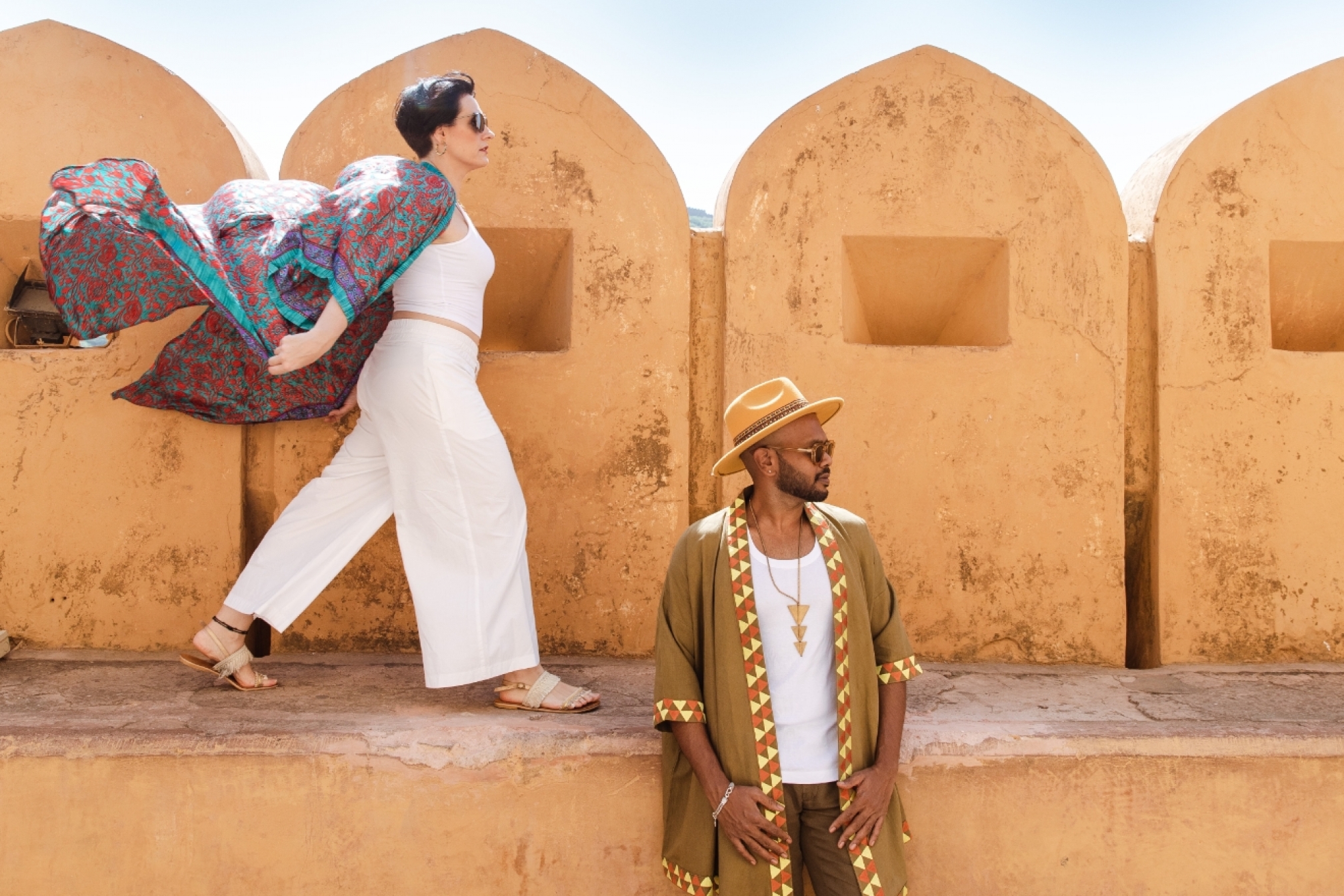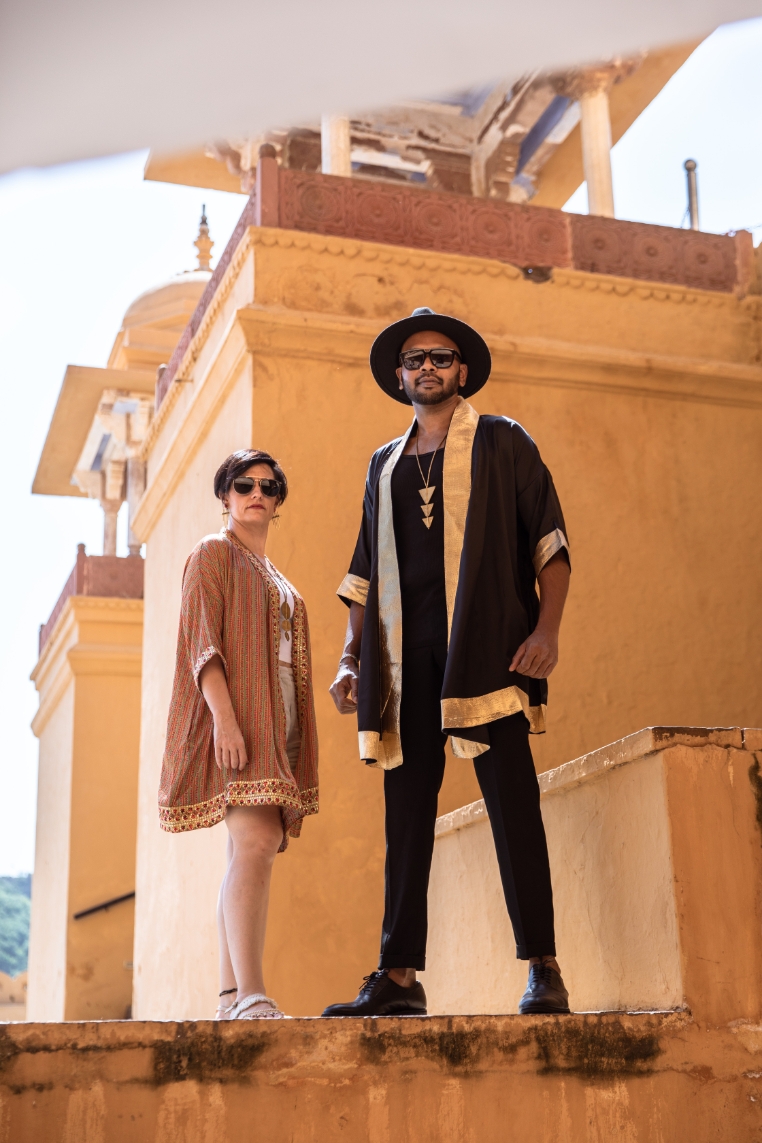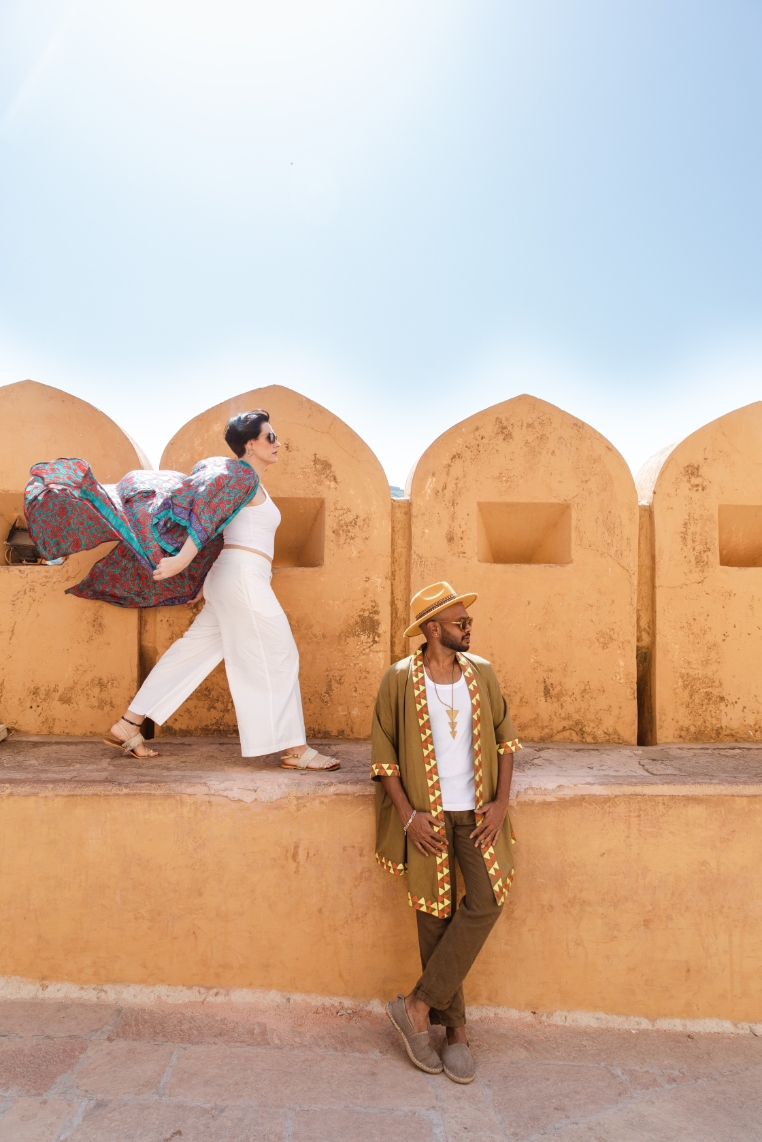 Interviews
Interviews
Raja Rani weave melodies, fashion & sustainability into their works of art
The Singapore-based duo are making their mark in multiple industries via eco-conscious kimonos & melodic sonic productions
Meet Naveen Murugan and Beatrice Nannini, the creative duo behind the electronic music duo Raja Rani, who intertwine a narrative steeped in music, fashion, and culture.
Their philosophy, "We love traditions, but we don’t like to follow rules", drives their desire to carve an independent path in their creative endeavours. Their mission is a seamless blend of Eastern festive energy and Western melodies on electronic dance floors, characterised by genre-fluid sets that surprise audiences by mixing Bollywood classics with techno grooves…plus their eco-friendly, colourful kimonos.
The versatile garment that symbolises their love for vibrant colours, tradition, and sustainability becomes an integral part of their creative journey — embracing sustainability, 80% of their pieces are crafted from preloved Indian sarees, breathing new life into these fabrics while championing conscious fashion choices.
Raja Rani’s impact has also resonated at festivals where both their vibrant tunes and striking kimonos are the hallmarks of sustainability, sparking awareness among attendees.
When it comes to their sonic repertoire, the two are proudly diverse yet converging. Naveen’s, soaked in Indian rhythms and the techno allure of London, merges with Beatrice’s, whose upbringing was immersed in Western classics and eventually delved into the depths of electronic music.
Proof of their harmonious fusion can be heard in their latest single ‘The Wolf of Wall Street’, which was just released under Awen Records. Inspired by a poignant moment in the film, the track’s throbbing basslines and hypnotising leads encapsulate the duo's desire to bring listeners back to the enthusiasm of an iconic scene. You’ll know exactly which one when you listen below.
As their story unfolds in Singapore and beyond, Raja Rani becomes a driving force in the local Singapore music and fashion scene, breathing life into the underground community.
After having the pleasure of meeting the two for myself, I felt like it's only right that our readers also get acquainted with the two who share a vision for a global community where music, fashion, and sustainability harmonise.
Read the full interview below.

Hi, Naveen and Bea! First things first; where did the name Raja Rani come from and what’s the philosophy behind it?
Raja Rani means King and Queen in Tamil; we are partners in life, in business, and in music; everything we do together is inspired by common passions and love. This is the message imprinted in both our products and music.
"We love traditions, but we don’t like to follow rules"; this is our mantra and philosophy for everything we do. We want to share the traditions of our cultures without following any social constructs or common practices. We want to create our own path.
Raja Rani's mission is to bring listeners on a journey that combines Indian festive energy and Western melodies on electronic music dance floors. It’s the festive energy that we strive to bring to the dance floor, promising to create that gas-igniting effect on every track we play and produce. We don’t like to lock ourselves in specific genres; we feel claustrophobic doing that.
We like to liberate ourselves by starting the set with a chilled organic house track, manoeuvring through various genres, and ending the night with a deep and dark techno track or a classic house number that everyone can sing along to. We are known for surprising the crowd with classic Bollywood songs mixed with tech house grooves or mixing Italian opera with throbbing techno basslines.
At the end of the night, the audience is not worried about what genre we play; it’s the energy we share on the dance floor. By keeping our sets genre-fluid, we always keep our audience curious about the sounds we share, but always coherent.
We have to ask...why kimonos?
Simply because it’s a garment that we’ve always loved to wear, especially for attending music festivals and parties! They’re super versatile, genderless, timeless, and size-free. They’re fun and easy to match with everything; they create a magical look even if underneath you’re wearing a simple t-shirt!
We liked the idea of kimono flowing with us while dancing; we liked the brightness of the colours and the powerful energy that they’re carrying within themselves.
We wanted to create cool looks that were able to connect traditional Indian sarees and lively colours, so we started testing different prints and finishes wearing them on social occasions.
Also, our friends were always asking where we bought them, and that was the beginning of this journey!

What made you want to delve into the unique intersection of electronic music, fashion and culture with your pieces? Where did this idea come from?
The connection between music and fashion comes naturally; it's an expression of art and a realisation of our common passions.
Naveen’s background is in music, both with his studies and his job, but his family business in India is in textiles; he has it in his blood, basically! In Singapore, he works as an audio designer for a leading AAA gaming company; sounds are part of his day-to-day life.
As for Beatrice, her background and studies are in marketing and fashion, but music has always been with her since a young age. Her father was the lead singer of a boy band back in the ‘70s, which translated into an avid listener of all sorts of tunes...and mainly a dancer of any kind of music!
What sustainable processes and practices are involved in a Raja Rani piece?
80% of our products are made from preloved sarees. These fabrics are so special because they carry a story with them; moreover, the prints and colours are incredibly unique, and we are able to give them a second life.
At the same time, they’re incredibly fragile; they require more time to procure and require more care to work with than new fabric, but we think that all the extra time we spend on them is worth it because of the love and appreciation that we receive from our clients. Even with the least waste we create, we turn them into headbands, scrunchies, and small bags.
To give you another example; we recently replaced our paper tags with recycled paper seed tags. Once you remove them from the garments, you can tear them down and plant them to make flowers!
Read this next: 21 in 2021: The year in sustainability (and music)
How do you see your efforts having a positive impact on both the environment (with its sustainability background) along with contributing to the music/festival scene?
Our goal is to educate people to make conscious choices in terms of fashion. We are constantly bombarded with ads from luxury brands, hiding the amount of waste in the textile industry. A report says that we are creating 92 million tonnes of textile waste every year. Our motto is also to enlighten the younger generations that you can still feel confident and fabulous wearing up-cycled clothes.
How we are doing this now is by wearing our colourful kimonos at all the events we play; people see them and want to buy them. When they reach out to us to purchase, they come to know the story behind the fabric, and we never fail to share the message; that’s how we are educating people.
We would like to take part in festivals around the world that share the same values as us when it comes to sustainability. More and more festivals are increasingly eco-friendly; we are participating in a few towards the end of this year, starting with The Conscious Festival, which just happened in mid-October, and continuing with Wonderfruit.
We love the fact that people are educated and responsible for their actions, and we hope that the era of finishing a festival and finding a carpet of bottles all over the event space will finally come to an end.

How about each of your personal preferences when it comes to electronic music; do you have similar or different tastes?
As you can imagine, we’re coming from such different backgrounds in terms of music. Naveen grew up in India, listening to the greatest composers like A.R. Rahman and Ilayaraja and, of course, the dance numbers of Bollywood. After he moved to London for his studies, he was influenced by drum'n'bass and mainly techno. He ended up falling in love with techno and never looking back.
Beatrice grew up with MTV and all the Western celebrities that were constantly on TV and radio, listening to all kinds of classics from the previous generation and getting close to modern jazz and contemporary music due to her dance studies.
Slowly arriving to electronic music and techno quite recently, searching for new forms of inspiration.
We are now both on the same ground, starting with organic house to tech house to melodic house & techno. We are coming from a very diverse starting point, but we are now in the same soundwave.
Read this next: Potato Head debuts a DJ booth made from 564 kgs of recycled plastic
Let's talk about your new release ‘The Wolf of Wall Street’; what inspired this particular track and how would you describe its sound? Is there a certain feeling you want to evoke in listeners with this track?
The movie ‘The Wolf of Wall Street’ is one of our favourite movies. If we’re talking about cinema and movies, we can definitely say that our tastes are far from each other. We often fight over what to watch, and it’s not so easy to find common ground.
But this specific movie hit us both in the same way; we were amazed and loved the same scenes, especially the one that we picked for the track.
The genius monologue of Matthew McConaughey and the expression of Leonardo diCaprio are unbeatable, and we wanted to encapsulate that moment with a track, frame the moment and keep it there with us. We want to bring back that Wolf Of Wall Street memory and create a special musical connection with the crowd.

You’ve been playing at a lot of parties in Singapore — tell us about those! How did that come to be?
Immediately after all the restrictions for COVID-19 were released, we started organising parties combining them with our kimonos, as we wanted to create awareness around our project. The response was surprisingly good; the crowd was having fun at our parties, enjoying the music, and appreciating our products.
After this first phase, many other events and pop-up parties started flourishing around the city, and thankfully, we’re now invited to play at parties as we’ve created a solid fan base and followers.
What’s the most bizarre or interesting gig you’ve played at?
This year we played our first gig outside of Singapore, in Vietnam, at The Lighthouse. It was extremely interesting because we had to exit from our comfort zone of Singapore, where we knew which kind of music would work better according to the location and the time of the day.
Playing in a different country and in a club that you’ve never visited was very challenging and extremely exciting!
Read this next: The Mixmag Asia Clubbing Guide: Singapore
What one DJ will always get you out of the house and onto the dance floor?
This is a very difficult question because there are many names that we can give you! But we can tell you a specific occasion that happened not long ago, in March.
We were participating at Boutique Fair, the main fair in Singapore for local brands and designers — a very important, intense and long event that lasts three full days from Friday morning until Sunday evening. We were at our booth for a minimum of 12 hours a day, but on Saturday night it was the first time Dixon was playing in Singapore. We couldn’t miss that gig even if on Sunday morning we had to go back to the fair and work all day long!
It was definitely worth it and we will do it again if the occasion comes. We love his music and his unique way of creating a journey.

What’s the best part about living in Singapore?
Singapore is the easiest place to live! Small and extremely efficient, the quality of life is higher than anywhere else in the world! Starting a business and living here, moving around with public transport and feeling safe in any moment of the day or night—it's pretty amazing.
And the worst?
The fact that it is a small country sometimes makes us feel a bit limited, for example, in terms of places to explore or nature to enjoy, we definitely need to jump on a flight and go somewhere else. But now that flying and travelling are back to normal, we only need a couple of hours to be in any chosen paradise!
When I think of Singapore, I think of the tastiest late-night grub. What’s your go-to for post-clubbing munchies?
Oh, we are very lucky because we have a very nice Sichuan restaurant near our house that is open until very late! We like to end our night with a little bit of spice!
Read this next: Singapore’s post-pandemic renaissance
What’s one thing the world doesn’t know about Singapore’s music scene?
Most probably, the image and idea that the rest of the world has of the Singapore music scene is the glittery one, the posh places like Ce La Vi and Marquee, which are great, don’t get us wrong!
What is not visible is the underground scene and the fervent community around it; new DJs and event organisers, pop-up parties in special locations, music lovers and dancers from all walks of life gathering to enjoy the music.
After COVID-19 restrictions were released, the underground community became more and more active, and we feel that this is a really interesting moment for the Singapore music scene.
What does the future of Raja Rani look like to you? Where would you like to see it in 10 years?
For us, sharing the music with the audience is a form of sharing love and energy. Seeing people go crazy with our music is the best feeling ever, and we want to cultivate this as much as we can, study, learn and grow to deliver better and better shows. Definitely, we want to continue to play music and create fashion; the two always go together!
Our vision in 10 years is to be part of an international music community where people share the same values we share for music, fashion and the environment. We would like to see our two babies, music and kimonos, grow and evolve together at the same time.
'The Wolf Of Wall Street' is out now via Awen Records. For more on Raja Rani, follow the duo on Instagram here.
Amira Waworuntu is Mixmag Asia’s Managing Editor, follow her on Instagram.


